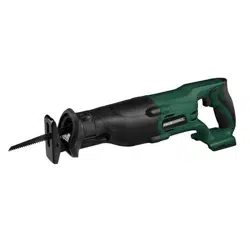Loading ...
Loading ...
Loading ...

Page 13
WARNING:
Do not plunge cut into
metal surfaces.
1. Insert the blade into the tool. If the blade
inserted with the teeth facing downward,
hold the tool as shown in Column A,
resting the edge of the shoe on
the workpiece.
2. If you inserted the blade with the teeth
facing upward, hold the tool as shown in
Column B, resting the edge of the shoe
on the workpiece as shown.
3. With the blade just above the workpiece,
depress the trigger switch, using the
edge of the shoe as a pivot, lower the
blade into the workpiece
4. As the blade starts cutting, raise the
handle of the tool slowly until the shoe
rest firmly on the workpiece. Then guide
the tool along your cutting line to acquire
the desired cut.
5. After the blade has penetrated through
the workpiece, continue sawing along
the marked cutting line.
NOTICE: To make plunge cutting easier, use
a heavy gauge blade and install the blade
with the teeth facing upward as show in
column B.
WARNING:
To reduce the risk of
explosion, electric shock and property
damage, always check the work area for
hidden gas pipes, electrical wires or water
pipes when making blind or plunge cut.
WARNING:
To avoid loss of control
and serious injury, make sure that the blade
reaches maximum speed before touching it
to the workpiece.
WARNING:
Do not make plunge
cuts in metal materials.
METAL CUTTING
The saw can be used to cut metals,
such as sheet steel, pipe, steel rods,
aluminum, brass, and copper. Be careful not
to twist or bend the saw blade. Do not force.
The use of cutting oil is recommend-
ed when cutting soft metals and steel.
Cutting oil will keep the blade cool, increase
cutting action, and prolong blade life.
WARNING:
Never use gasoline,
because normal sparking could ignite the
fumes.
1. Securely clamp the workpiece in
position, and make the cut close
to the clamping point in order to
minimize vibration of the work
being cut.
2. When cutting conduit pipe or an-
gle iron, clamp the work in a vise, if
possible, and cut close to the vise.
3. To cut thin sheet material,
“sandwich” the material between
pieces of hardboard or plywood,
and clamp the layers together in
order to reduce vibration and
tearing of the material.
OPERATION
Loading ...
Loading ...
Loading ...
